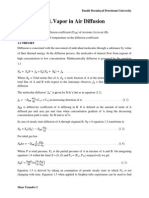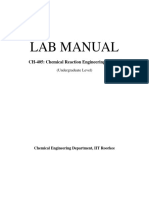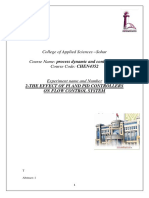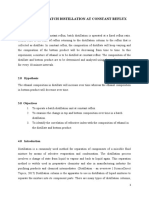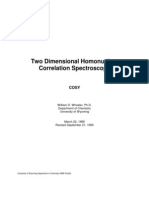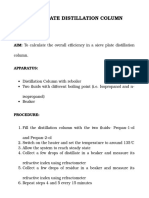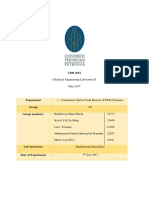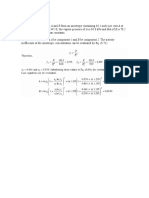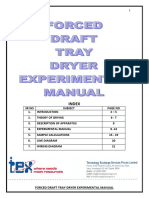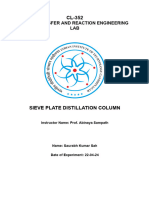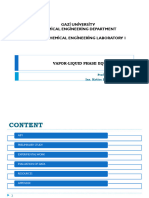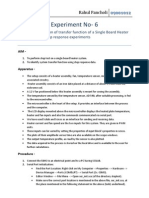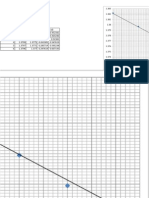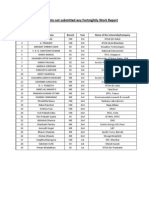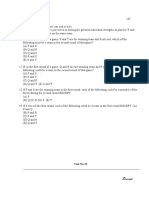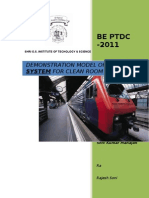Sieve Plate Distillation
Sieve Plate Distillation
Uploaded by
Rahul PancholiCopyright:
Available Formats
Sieve Plate Distillation
Sieve Plate Distillation
Uploaded by
Rahul PancholiOriginal Description:
Copyright
Available Formats
Share this document
Did you find this document useful?
Is this content inappropriate?
Copyright:
Available Formats
Sieve Plate Distillation
Sieve Plate Distillation
Uploaded by
Rahul PancholiCopyright:
Available Formats
Experiment 5 Sieve Tray Distillation
AIM:To determine the overall efficiency of the sieve plate distillation column and to calculate number of plates using experimental data. APPARATUS:o o o THEORY:Distillation is a separation process in which a new phase is generated by heating the mixture. The difference in relative volatility of components is exploited in the process. In our case relative volatility of Iso-propanol is more than propane-1-ol. In sieve tray distillation mixture is fed to the bottom of the column and heated through hot oil. The vapour is passed through plates and liquid is been fed from top of the column as a reflux. LAB SETUP:Due to sieves and the liquid hold up over plates there is bubbling of heated vapor phase through liquid phase providing contact area for the mass transfer. PROCEDURE: Add mixture into reboiler. Hot oil is circulated through shell side of the reboiler which work as a heating medium. Start the heater. Vapors will flow upwards and distillate is been accumulated and after few minutes there will be a reflux coming in. Collect the samples of distillate and residue. Get the value of the refractive index by refractometer. When the values of refractive indexes become constant we can find number of plates using Mc-Cabe Thille method. Calculate the efficiency Sieve plate distillation column 87 : 13 mixture of propane-1-ol and Iso-propanol Refractometer
DATA FROM THE LITERATURE:-
Molecular weight of both A and B Propane-1-ol = 60 gm/ mol Iso-propanol = 60 gm/mol Refractive index v/s mole fraction data. Propane-1-ol = 1.3822 D Iso-propanol = 1.3740 D
Calibration Curve for Propane-1-ol and Iso-propanol mixture
1.383 1.382 1.381 1.38 1.379 1.378 1.377 1.376 1.375 1.374 1.373 0 0.1 0.2 0.3 0.4 0.5 0.6 0.7 0.8 0.9 1
Observation Table sample No. 1 2 3 4 5 6 RI (w) 1.3805 1.3803 1.3801 1.3799 1.3797 1.3796 RI ( D) 1.3783 1.3782 1.3777 1.3775 1.3771 1.377 X (w) 0.190476 0.214286 0.238095 0.261905 0.285714 0.297619 X (d) 0.452381 0.464286 0.52381 0.547619 0.595238 0.607143
CONCLUSION AND DISCUSSION: Total number of plates from mcCabe thille method= 2.37 Efficiency of the tower =2.37/4 *100 % = 59.25% According to experimental setup there are only 3 plates and one reboiler but there can be more number of plates. The reason of not having number of plates having the concentration set up in the critical zone of having equilibrium data is that the contribution of the number of the plates is negligible and composition difference can be easily measured by the calibration curve. According to the calibration curve, the RI of Iso- propanol is inversely proportional to the concentration. The R.I. of the mixture depends on the components of the mixture and nature of dependence of the curve depends on the composition of the mixture. In the case of total reflux the diagonal line will work as an operation line.
You might also like
- Lab Report Batch Reactor GGDocument25 pagesLab Report Batch Reactor GGFrost Orchid100% (1)
- Result & Discussion Exp Tray DryerDocument6 pagesResult & Discussion Exp Tray Dryerfatin noraini71% (7)
- Diesel Engine Generator Set Site Acceptance Test Procedure 48 JamDocument7 pagesDiesel Engine Generator Set Site Acceptance Test Procedure 48 Jambambang ismail100% (4)
- Flower FaceDocument2 pagesFlower FaceTherese Marie Militante100% (1)
- Experiment No. 4 Loading and Flooding Characteristics of A Packed ColumnDocument13 pagesExperiment No. 4 Loading and Flooding Characteristics of A Packed ColumnYash JainNo ratings yet
- Vapor in Air DiffusionDocument6 pagesVapor in Air DiffusionMeetNo ratings yet
- Lab Manual (Cre)Document41 pagesLab Manual (Cre)akash100% (1)
- Flash Distillation ProblemDocument2 pagesFlash Distillation ProblemprudhvifireNo ratings yet
- Laboratory Report 10 (Drag On A Sphere)Document16 pagesLaboratory Report 10 (Drag On A Sphere)Wang WeiXinNo ratings yet
- The Effect of Pi and Pid Controllers On Flow Control SystemDocument16 pagesThe Effect of Pi and Pid Controllers On Flow Control SystemahedooohNo ratings yet
- Lab Report DistillationDocument13 pagesLab Report DistillationWong XimeiNo ratings yet
- Experiment 2 - Study of Packed Column DistillationDocument7 pagesExperiment 2 - Study of Packed Column DistillationAdawiyah Az-zahra100% (1)
- Lab 2 Brief DepressurizationDocument6 pagesLab 2 Brief DepressurizationRenissha Nair100% (2)
- CSTRDocument20 pagesCSTRSharing Caring100% (1)
- McosyDocument10 pagesMcosyLola Perez LolaNo ratings yet
- Lab Manual Fall 2017Document68 pagesLab Manual Fall 2017Nil SabbirNo ratings yet
- VI Sem Mass Transfer Lab ManualDocument53 pagesVI Sem Mass Transfer Lab Manualoctoviancletus80% (10)
- Sieve Plate Distillation ColumnDocument9 pagesSieve Plate Distillation ColumnAshish VermaNo ratings yet
- Sieve Plate Distillation Column - Lab ReportDocument4 pagesSieve Plate Distillation Column - Lab ReportShrankhla NaryaNo ratings yet
- Exp-9 - Liquid Liquid Extraction in A Packed ColumnDocument5 pagesExp-9 - Liquid Liquid Extraction in A Packed ColumnSiddharth MohapatraNo ratings yet
- Experiment 4 EmissivityDocument13 pagesExperiment 4 EmissivitySanjith Kaur100% (1)
- Exp 2 Bubble Cap DistillationDocument7 pagesExp 2 Bubble Cap DistillationFaris HamirNo ratings yet
- Cre Lab Manual 18bt01035Document55 pagesCre Lab Manual 18bt01035SARTHAK LATHIYANo ratings yet
- Saponification Reaction of Sodium Hydroxide An Ethyl Acetate in A Continuous Stirred Tank Reactor CSTRDocument21 pagesSaponification Reaction of Sodium Hydroxide An Ethyl Acetate in A Continuous Stirred Tank Reactor CSTRsyedmuhammadtarique100% (1)
- Absorption in Packed Bed Lab ManualDocument5 pagesAbsorption in Packed Bed Lab ManualAshish Verma100% (1)
- Lab Report Aspen Hysis UiTMDocument12 pagesLab Report Aspen Hysis UiTMAhmad SiddiqNo ratings yet
- Exp3 Fluid MixingDocument2 pagesExp3 Fluid MixingMoony Light100% (1)
- Investigation of Liquid-Solid and Gas-Solid Fluidized BedDocument18 pagesInvestigation of Liquid-Solid and Gas-Solid Fluidized Bedmahbub1332100% (1)
- S.no. Name of The Experiment Date of Conduction Date of Submission P2 Cascade CSTR 4 February, 2021 9 February, 2021Document14 pagesS.no. Name of The Experiment Date of Conduction Date of Submission P2 Cascade CSTR 4 February, 2021 9 February, 2021DEEPSHIKA DUTTANo ratings yet
- Exp. 8 Diffusion of Sodium Chloride in WaterDocument6 pagesExp. 8 Diffusion of Sodium Chloride in WaterElaine Pui33% (3)
- Schx4007 Mass Transfer LabDocument60 pagesSchx4007 Mass Transfer LabAhmed AliNo ratings yet
- Isothermal Semi-Batch Reactor PPT RJC SirDocument16 pagesIsothermal Semi-Batch Reactor PPT RJC Sirsdjdsf100% (1)
- Liquid - Liquid Extraction in A Packed Bed: Experiment No: 2Document23 pagesLiquid - Liquid Extraction in A Packed Bed: Experiment No: 2Sameep JainNo ratings yet
- Exp. 8 Diffusion of Sodium Chloride in WaterDocument6 pagesExp. 8 Diffusion of Sodium Chloride in WaterElaine Pui100% (1)
- Experiment 2 - Forced Draft Cooling TowerDocument14 pagesExperiment 2 - Forced Draft Cooling TowerSonia YuNo ratings yet
- Fluidization Bed Column Lab ManualDocument10 pagesFluidization Bed Column Lab ManualAshish VermaNo ratings yet
- Exp - S1A - Solid in Air DiffusionDocument7 pagesExp - S1A - Solid in Air DiffusionAnuj SrivastavaNo ratings yet
- Experiment No 1 (Tray Dryer)Document8 pagesExperiment No 1 (Tray Dryer)mjunaidNo ratings yet
- Lab Report 4 (Physical Chemistry)Document10 pagesLab Report 4 (Physical Chemistry)Hanif YusofNo ratings yet
- Distillation CurveDocument9 pagesDistillation CurveAmmar .kNo ratings yet
- Vapor Liquid Equilibrium (Ethanol+water)Document13 pagesVapor Liquid Equilibrium (Ethanol+water)Mahe Rukh100% (4)
- Lab 10-Batch ReactorDocument22 pagesLab 10-Batch Reactorniraj_bairagiNo ratings yet
- Experiment 1 CSTR DynamicsDocument24 pagesExperiment 1 CSTR DynamicsFarhan Hazeeq50% (2)
- Dynamic Response of A U Tube ManometerDocument8 pagesDynamic Response of A U Tube ManometerRitikranjan YadavNo ratings yet
- Experiment 3 Comparison Between PumpsDocument11 pagesExperiment 3 Comparison Between PumpsOsama Rashayda100% (2)
- 101.3 Kpa and 345 K. at 345 K, The Vapour Pressure of A Is 84.8 Kpa and That of B Is 78.2 Kpa. Calculate The Van Laar ConstantsDocument11 pages101.3 Kpa and 345 K. at 345 K, The Vapour Pressure of A Is 84.8 Kpa and That of B Is 78.2 Kpa. Calculate The Van Laar ConstantsAlexander Abel Ramos Rojas100% (1)
- Force Draft Tray Dryer Experimental ManualDocument21 pagesForce Draft Tray Dryer Experimental ManualShoaib Pathan100% (3)
- Lab Report CSTR 40LDocument26 pagesLab Report CSTR 40LAnonymous NyvKBW33% (3)
- CSTR Lab ReportDocument14 pagesCSTR Lab ReportAmy Farhana33% (3)
- CRE-II - Chapter-04 Fluid-Particle Systems - HKB 2.10.18Document42 pagesCRE-II - Chapter-04 Fluid-Particle Systems - HKB 2.10.18Ananya DaveNo ratings yet
- Particle DragDocument21 pagesParticle DragKHAIRUNISANo ratings yet
- Tray Drying Report PDFDocument10 pagesTray Drying Report PDFJoson Chai100% (2)
- RI Vs Composition Methanol-Water MixtureDocument12 pagesRI Vs Composition Methanol-Water MixtureAnonymous VeJYFSMWLINo ratings yet
- Fluid Mixing LabDocument19 pagesFluid Mixing LabFatinnnnnn67% (3)
- Experiment 5 Gas Diffusion Coefficient: ObjectivesDocument8 pagesExperiment 5 Gas Diffusion Coefficient: ObjectivesFadhlin SakinahNo ratings yet
- CHE246 - Technical Lab Report On Rotary PDFDocument5 pagesCHE246 - Technical Lab Report On Rotary PDFanujaNo ratings yet
- Corrosion Lab ReportDocument10 pagesCorrosion Lab ReportSAFINA KAMAL SHOILYNo ratings yet
- Lab ManualDocument24 pagesLab ManualAasia FarrukhNo ratings yet
- CLP302 - MT (SG 6) - Merged (1) 2Document62 pagesCLP302 - MT (SG 6) - Merged (1) 2hedavo3338No ratings yet
- Sieve Plate DistillationDocument10 pagesSieve Plate DistillationSaurabh SaraffNo ratings yet
- DistillationDocument8 pagesDistillationfarahalsayed64No ratings yet
- 3b Vapor Liquid Phase EquilibriumDocument19 pages3b Vapor Liquid Phase EquilibriumMelisa KahramanNo ratings yet
- Height in CmsDocument23 pagesHeight in CmsRahul PancholiNo ratings yet
- Thermowell Pseudo First Order SystemDocument2 pagesThermowell Pseudo First Order SystemRahul PancholiNo ratings yet
- Experiment No-8: SBHS3: Feedback Control of Temperature Using Heater Input-An Experimental StudyDocument3 pagesExperiment No-8: SBHS3: Feedback Control of Temperature Using Heater Input-An Experimental StudyRahul PancholiNo ratings yet
- SBSH ReadingsDocument94 pagesSBSH ReadingsRahul PancholiNo ratings yet
- SBHS1Document5 pagesSBHS1Rahul PancholiNo ratings yet
- Second Order Under Damped System DynamicsDocument6 pagesSecond Order Under Damped System DynamicsRahul PancholiNo ratings yet
- Food PreservativesDocument13 pagesFood PreservativesRahul Pancholi100% (2)
- CalandriaDocument2 pagesCalandriaRahul PancholiNo ratings yet
- Propyl Isopropyl Calibration Curve and Readings of Seive Tray DistillationDocument2 pagesPropyl Isopropyl Calibration Curve and Readings of Seive Tray DistillationRahul PancholiNo ratings yet
- Digital Lab Project - Write UpDocument2 pagesDigital Lab Project - Write UpRahul PancholiNo ratings yet
- RTD in CSTRDocument7 pagesRTD in CSTRRahul Pancholi100% (5)
- Fortnightly ReportDocument1 pageFortnightly ReportRahul PancholiNo ratings yet
- Stone and Architecture in The Mountains of Jordan and SyriaDocument257 pagesStone and Architecture in The Mountains of Jordan and SyriamijazNo ratings yet
- Newton'S Laws of Motion: Mark Anthony C. Burgonio, MSCDocument37 pagesNewton'S Laws of Motion: Mark Anthony C. Burgonio, MSCChristel GonzalesNo ratings yet
- Datasheet ICDL Office Application Essentials EngDocument1 pageDatasheet ICDL Office Application Essentials Engmohammedomer1911No ratings yet
- Desalination Lesson For KidsDocument3 pagesDesalination Lesson For KidsNovember FelimonNo ratings yet
- AP Physics C Electricity Study GuideDocument25 pagesAP Physics C Electricity Study GuideLama DiriyehNo ratings yet
- Chapter 4Document58 pagesChapter 4Agha Salman HaiderNo ratings yet
- Standard Examination July 2022for Study2023Document23 pagesStandard Examination July 2022for Study2023Tshiamo MotaungNo ratings yet
- Design of A 4 Bit Arithmetic and Logical Unit With Low Power and High SpeedDocument6 pagesDesign of A 4 Bit Arithmetic and Logical Unit With Low Power and High SpeedmadhuriNo ratings yet
- Fans SoftDocument291 pagesFans SoftAmitava PalNo ratings yet
- HSB Bcom Ii Year C++ PDFDocument1 pageHSB Bcom Ii Year C++ PDFSavari RajNo ratings yet
- Mayur Final Project 2Document75 pagesMayur Final Project 2Mala.hrNo ratings yet
- DFSS2Document1 pageDFSS2Derkung BenowatNo ratings yet
- Test 13Document11 pagesTest 13CMasood.ANo ratings yet
- 1105deDocument398 pages1105deNhật PhạmNo ratings yet
- How Yaffs WorksDocument25 pagesHow Yaffs WorkseemkutayNo ratings yet
- Session 2Document15 pagesSession 2Rumble kingNo ratings yet
- Units Ops 2 Midterm ProjDocument7 pagesUnits Ops 2 Midterm ProjmarielNo ratings yet
- Sensivity LucDocument12 pagesSensivity LuchariwanfadhilNo ratings yet
- SL40SVCDocument35 pagesSL40SVCgeorgeclima4103No ratings yet
- Cantilever Bridge: S. Vivekananda Sharma M.TECH, 2 Semester 2018-19Document30 pagesCantilever Bridge: S. Vivekananda Sharma M.TECH, 2 Semester 2018-19vivekananda sharmaNo ratings yet
- Vijay SCOTCH YOKE MECHANISM DOUBLE ACTING HACKSAWDocument31 pagesVijay SCOTCH YOKE MECHANISM DOUBLE ACTING HACKSAWSergio PugazhNo ratings yet
- Chapter 16,2019 PDFDocument29 pagesChapter 16,2019 PDFHtet AungNo ratings yet
- Assignment On Vector and MatrixDocument7 pagesAssignment On Vector and MatrixpayigiyNo ratings yet
- Project Report FinalDocument45 pagesProject Report FinalDushyant Malla100% (5)
- Stpmic 1Document141 pagesStpmic 1NalsonNo ratings yet
- EE650 L11bDocument17 pagesEE650 L11braghav shuklaNo ratings yet
- Problemset1 10Document12 pagesProblemset1 10Juan Marquina CancinoNo ratings yet





